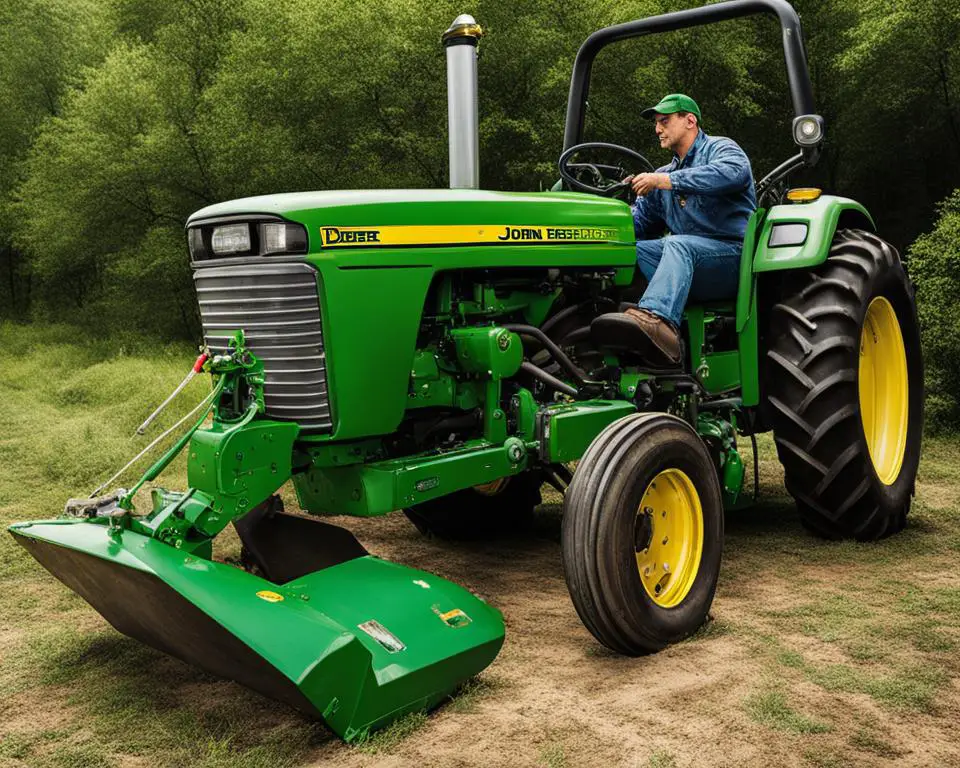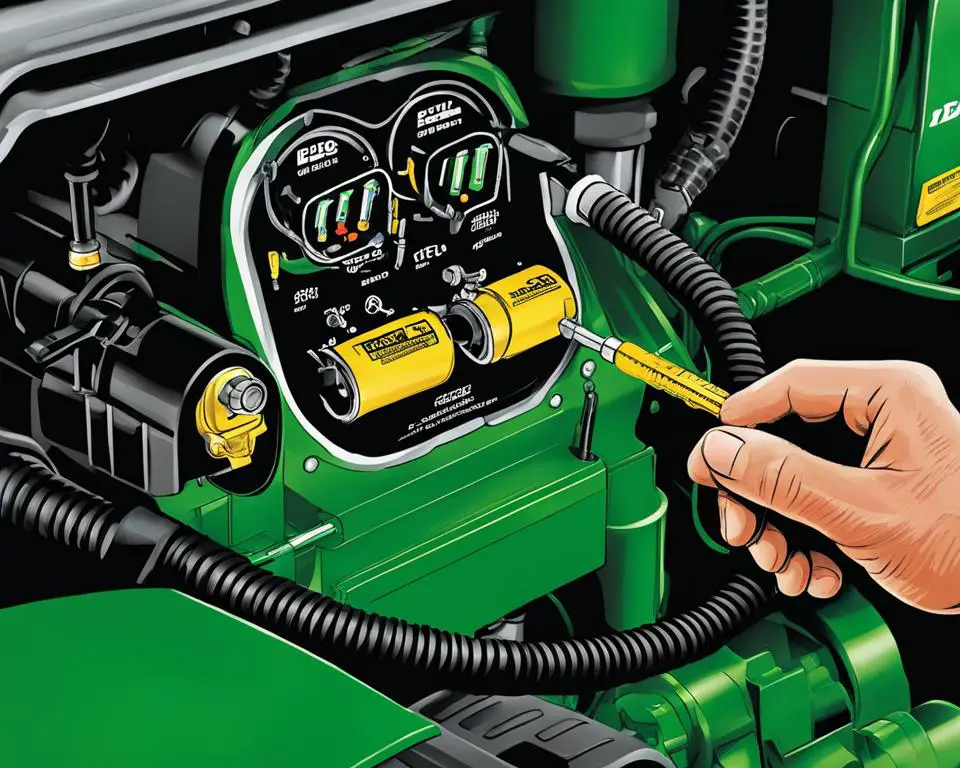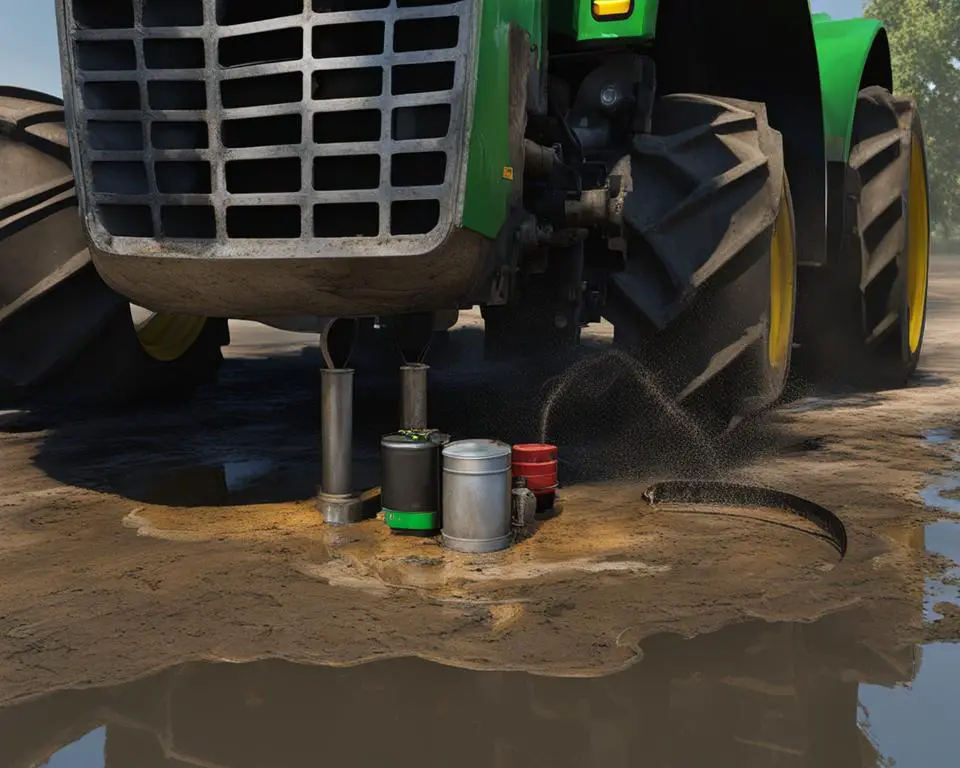If you own a John Deere 7810 tractor, you may have encountered some common issues that can affect its performance. Troubleshooting these problems is essential to ensure your tractor runs smoothly and efficiently. In this article, we will explore the most common issues with the John Deere 7810 and provide valuable troubleshooting tips to help you address them effectively.
From starting issues to fuel system malfunctions, we will delve into the common problems that many John Deere 7810 owners have encountered. By understanding these issues and their potential causes, you can take proactive measures to maintain your tractor’s optimal performance.
So, if you’re ready to troubleshoot the common problems plaguing the John Deere 7810, let’s dive in and unravel the mysteries behind these issues.
Signs of a Faulty Fuel Transfer Pump
If the fuel transfer pump in a John Deere 7810 is not functioning properly, there are several signs that may indicate its failure. One common symptom is the absence of a clicking noise from the pump when the key is in the “on” position. Additionally, the engine may not receive any fuel, leading to a failure to start or a rough start followed by stalling. Checking the fuel filter water separator can also provide insights into the fuel flow and potential pump issues.
“If the fuel transfer pump isn’t clicking when you turn the key, it could be a sign of failure. Likewise, if your engine is having trouble starting or stalling after a rough start, it might be a symptom of a faulty fuel transfer pump. Don’t forget to inspect the fuel filter water separator for any issues with fuel flow.”
When the fuel transfer pump fails, it can disrupt the fuel delivery process and affect the overall performance of the John Deere 7810. Identifying these signs of failure early on can help prevent further damage and timely address any fuel pump issues.
| Symptom | Description |
|---|---|
| Absence of clicking noise | No clicking sound from the fuel transfer pump when the key is turned to the “on” position. |
| No fuel delivery | The engine fails to receive fuel, resulting in starting issues or a rough start followed by stalling. |
| Fuel filter water separator | Inspecting the fuel filter water separator reveals issues with fuel flow and potential pump problems. |
Troubleshooting Steps for Fuel Flow Issues
To troubleshoot fuel flow issues in a John Deere 7810, there are several key steps you can follow to identify and address the problem. These troubleshooting steps will help you pinpoint any potential restrictions or blockages in the fuel line, ensuring a smooth and consistent fuel flow to the engine.
- Step 1: Check the Fuel Shut-off Valve
Ensure that the fuel shut-off valve is open and allowing fuel to flow. Sometimes, a closed or partially closed fuel shut-off valve can lead to fuel flow issues.
- Step 2: Verify Fuel Tank Level
Make sure the fuel tank is filled to the top. Gravity feed from a full tank can help prime the fuel system and ensure an uninterrupted flow of fuel.
- Step 3: Inspect Fuel Line for Blockages
Check the fuel line for any restrictions or blockages that may be hindering the fuel flow. Start from the tank and visually inspect the fuel line as you move towards the engine. Cracking the couplings and visually inspecting for fuel flow can help identify any potential issues.
- Step 4: Address any Fuel Line Issues
If you find any blockages or restrictions in the fuel line, take necessary measures to address them. This may involve cleaning the fuel line or replacing any damaged or faulty sections.
- Step 5: Ensure Proper Fuel Line Connections
Check that all fuel line connections are secure and properly tightened. Loose or faulty connections can cause fuel flow issues, so ensure everything is properly connected.
By following these troubleshooting steps, you can diagnose and resolve fuel flow issues in your John Deere 7810. Remember to take necessary safety precautions and consult the tractor’s manual for specific instructions on troubleshooting and maintenance.

Importance of Proper Fuel Pump Functioning
The fuel pump is a critical component in the engine operation of the John Deere 7810. It plays a key role in delivering fuel from the tank to the high-pressure pump, ensuring a continuous fuel supply for optimal performance.
Without proper functioning of the fuel pump, the engine may not receive the required fuel to start and run smoothly. This can result in starting issues, poor acceleration, and overall decreased performance.
The fuel transfer pump in the John Deere 7810 tractors is designed to be self-priming. This means that it is capable of priming the fuel system on its own, making it easier to start the engine after maintenance or fuel filter replacement.
“The fuel pump is a crucial component that directly affects the engine’s operation and fuel delivery.”
Fuel Pump Functioning and Self-Priming
The fuel pump in the John Deere 7810 is responsible for drawing fuel from the tank and delivering it at the correct pressure to the high-pressure pump. It ensures a continuous flow of fuel to the engine, allowing for smooth and efficient operation.
One notable advantage of the fuel transfer pump in these tractors is its self-priming capability. Self-priming means that the fuel pump can automatically remove any air from the fuel system and create a vacuum. This allows the pump to quickly and effectively prime itself without manual intervention, simplifying the starting process.

The Impact of Fuel Pump Issues
When the fuel pump malfunctions or fails to operate properly, it can have a significant impact on the tractor’s performance and overall engine operation. Some potential consequences of fuel pump issues include:
- Poor fuel delivery to the high-pressure pump
- Inadequate fuel pressure
- Engine misfires or stalls
- Difficulty starting the engine
- Reduced power and efficiency
Addressing fuel pump issues promptly is essential to avoid these problems and maintain optimal engine performance.
Summary
The fuel pump’s proper functioning is crucial for the engine operation and fuel delivery in the John Deere 7810. It ensures a continuous fuel supply, allowing the engine to start smoothly and run efficiently. The self-priming capability of the fuel transfer pump simplifies the starting process, making it easier to address maintenance or filter replacement. Any issues with the fuel pump must be diagnosed and resolved promptly to avoid performance problems.
Additional Factors to Consider
In addition to the fuel transfer pump, several other components in the fuel system of a John Deere 7810 can contribute to starting issues. Regular maintenance and inspection of these components can help prevent potential problems and ensure optimal performance.
Sediment Bowl Inspection
One crucial component to inspect is the sediment bowl. This bowl is designed to catch any sediment or debris that may be present in the fuel tank, preventing it from reaching the fuel system. Over time, the sediment bowl can accumulate a significant amount of debris, which can obstruct fuel flow or lead to fuel contamination. Regularly inspecting and cleaning the sediment bowl can help maintain a clean and unrestricted fuel system.
Electrical Glitches
Electrical glitches can also disrupt the proper functioning of the fuel pump. Components such as the fuel shut-off solenoid or wiring connections can develop faults or become loose, resulting in unreliable fuel delivery. Regularly inspecting the electrical components of the fuel system can help identify and address any glitches before they cause starting issues.
Fuel System Maintenance
Maintaining the fuel system is essential for preventing starting issues. The fuel filter, in particular, plays a critical role in ensuring clean fuel reaches the engine. Over time, the fuel filter can become clogged with dirt, debris, or water, restricting fuel flow. Regularly inspecting and replacing the fuel filter according to the manufacturer’s recommendations can help prevent clogs and restrictions, ensuring proper fuel delivery.
Additionally, it is important to perform regular maintenance tasks such as checking fuel line connections and ensuring the fuel shut-off valve operates correctly. These simple maintenance steps can help prevent potential starting issues and optimize the performance of the John Deere 7810.
Regular Fuel System Maintenance Checklist
| Component | Maintenance Task |
|---|---|
| Fuel Filter | Inspect and replace regularly |
| Sediment Bowl | Inspect and clean regularly |
| Fuel Lines | Check for leaks and secure connections |
| Fuel Shut-off Valve | Ensure proper operation |
| Electrical Connections | Inspect for faults or loose connections |
By following these maintenance guidelines and regularly inspecting the fuel system components, John Deere 7810 owners can minimize the risk of starting issues and ensure the reliable operation of their tractor.

Safety Precautions When Troubleshooting Fuel System
When troubleshooting the fuel system of a John Deere 7810, it is crucial to prioritize safety precautions to prevent potential accidents or injuries. Working with high-pressure lines and fuel injection requires careful attention and adherence to safety guidelines. Here are some essential safety precautions to consider:
1. Wear Eye Protection and Protective Clothing
Before starting any fuel system troubleshooting, ensure you are wearing appropriate eye protection and protective clothing. Safety glasses or goggles can shield your eyes from any fuel splashes or debris. Additionally, wear gloves, a long-sleeved shirt, and pants to protect your skin from potential contact with diesel fuel or fuel components.
2. Lay a Cloth Over High-Pressure Lines
When troubleshooting high-pressure lines, it is recommended to lay a cloth or rag over the lines before cracking them open. This precaution helps to slow down the fuel flow, reducing the risk of fuel injection under the skin. By taking this simple step, you can minimize the chances of injury.
3. Follow Proper Fuel System Shutdown Procedures
Before working on the fuel system, ensure the tractor is turned off, and the key is removed from the ignition. This step prevents accidental fuel injection or ignition while troubleshooting. Always refer to the manufacturer’s guidelines for specific shutdown procedures.
4. Avoid Open Flames or Sparks
Ensure there are no open flames or sparks in the vicinity while troubleshooting the fuel system. Diesel fuel is highly flammable, and any ignition source can lead to a dangerous situation. Keep the work area clear of potential fire hazards and work in a well-ventilated space.
5. Handle Fuel with Care
When dealing with fuel components, exercise caution to avoid spills or leaks. Follow proper fuel handling procedures and use suitable containers for storing or transporting fuel. Clean up any fuel spills immediately and dispose of waste in accordance with local regulations.
Taking these safety precautions when troubleshooting the fuel system of a John Deere 7810 ensures your well-being and minimizes the risk of accidents. Remember, safety should always be the top priority in any maintenance or repair task.
Importance of Regular Fuel System Maintenance
Regular maintenance of the fuel system is crucial for the proper functioning of a John Deere 7810 tractor. By implementing preventive measures and staying on top of fuel system maintenance, owners can ensure optimal performance and prevent potential starting issues. One key aspect of fuel system maintenance is inspecting and replacing the fuel filter regularly.
The fuel filter plays a critical role in preventing any clogs or restrictions that may impede the flow of fuel to the engine. Over time, the fuel filter can accumulate dirt, debris, and contaminants, hindering its effectiveness. By regularly inspecting and replacing the fuel filter, tractor owners can maintain a clean and unobstructed fuel system, promoting smooth engine operation.
The Importance of Fuel Filter Replacement
As part of fuel system maintenance, it is recommended to replace the fuel filter at regular intervals or as advised by the manufacturer. A new fuel filter ensures that the fuel entering the engine is free from impurities, maintaining fuel flow and preventing potential issues.
Replacing the fuel filter is a relatively simple task that can be performed by tractor owners themselves. The process typically involves locating the fuel filter, disconnecting the fuel lines, removing the old filter, and installing a new one. Following the manufacturer’s instructions and guidelines is essential to ensure proper installation and functionality.
In addition to fuel filter replacement, it is important to pay attention to other components of the fuel system during regular maintenance. Owners should inspect the fuel shut-off valve to ensure proper functioning and inspect all wiring connections to prevent electrical glitches that may affect the fuel pump.
By prioritizing fuel system maintenance and taking preventive measures such as fuel filter replacement, tractor owners can extend the lifespan of their John Deere 7810 and avoid costly repairs. Regular maintenance not only enhances the reliability and performance of the tractor but also contributes to overall safety and efficiency on the field.
Summary:
- Regular fuel system maintenance is essential for optimal performance.
- Inspect and replace the fuel filter regularly to prevent clogs and restrictions.
- Follow manufacturer’s instructions for fuel filter replacement.
- Check the fuel shut-off valve and wiring connections during maintenance.
- Prioritize maintenance to prevent potential starting issues and ensure safety and efficiency.
Conclusion
In conclusion, the John Deere 7810 may encounter starting issues related to its fuel system, particularly the fuel transfer pump. To troubleshoot these problems, it is essential to check the fuel flow, inspect the fuel shut-off valve, and ensure the fuel line’s integrity. Regular maintenance of the fuel system, including timely fuel filter replacement, plays a crucial role in preventing potential starting difficulties. By following these troubleshooting tips and taking the necessary safety precautions, owners of the John Deere 7810 can effectively address and resolve common fuel system-related problems.
Proper fuel system maintenance is of utmost importance to ensure the optimal performance of the John Deere 7810. By inspecting and replacing the fuel filter on a regular basis, owners can prevent clogs and restrictions that may hinder the fuel flow. Additionally, ensuring the correct functioning of the fuel shut-off valve and secure wiring connections can help avoid potential starting issues. By conscientiously maintaining the fuel system, tractor owners can safeguard against problems and enjoy uninterrupted operation.
In summary, when encountering starting problems with the John Deere 7810, it is crucial to focus on the fuel system. Troubleshooting steps such as checking fuel flow, inspecting the fuel shut-off valve, and maintaining the fuel line’s integrity can help identify and resolve common issues. Regular fuel system maintenance, including fuel filter replacement, should be prioritized to prevent potential starting difficulties. By adhering to these troubleshooting tips and prioritizing fuel system maintenance, John Deere 7810 owners can tackle common problems effectively and ensure the smooth operation of their tractors.
FAQ
What are some common issues with the John Deere 7810?
Common issues with the John Deere 7810 include starting problems related to the fuel system, particularly the fuel transfer pump. Other potential causes include a clogged fuel line or a faulty fuel shut-off valve.
What are the signs of a faulty fuel transfer pump in a John Deere 7810?
Signs of a faulty fuel transfer pump in a John Deere 7810 may include the absence of a clicking noise from the pump when the key is in the “on” position and the engine not receiving any fuel, leading to a failure to start or a rough start followed by stalling.
What are the troubleshooting steps for fuel flow issues in a John Deere 7810?
To troubleshoot fuel flow issues in a John Deere 7810, start by ensuring that the fuel shut-off valve is open and that the fuel tank is filled to the top. Next, check for fuel flow at various points in the system, starting from the tank and moving towards the engine.
Why is proper fuel pump functioning important in a John Deere 7810?
Proper fuel pump functioning is important in a John Deere 7810 as the fuel pump is responsible for delivering fuel from the tank to the high-pressure pump. Without proper functioning of the fuel pump, the engine may not receive the required fuel to start and run smoothly.
What other factors should be considered in the fuel system of a John Deere 7810?
Other factors to consider in the fuel system of a John Deere 7810 include the regular inspection and replacement of the fuel filter to prevent clogs or restrictions, as well as potential electrical glitches such as a faulty fuel shut-off solenoid or wiring connection.
What safety precautions should be taken when troubleshooting the fuel system of a John Deere 7810?
When troubleshooting the fuel system of a John Deere 7810, it is important to wear eye protection and protective clothing. Additionally, laying a cloth over the high-pressure line can help slow down the fuel flow and reduce the risk of injury.
Why is regular fuel system maintenance important for a John Deere 7810?
Regular fuel system maintenance is important for a John Deere 7810 as it helps prevent potential starting issues. This includes inspecting and replacing the fuel filter regularly, ensuring the fuel shut-off valve is functioning correctly, and securing all wiring connections.
What are some troubleshooting tips for addressing common starting issues with the John Deere 7810?
To troubleshoot and address common starting issues with the John Deere 7810, it is recommended to check for proper fuel flow, inspect the fuel shut-off valve, and ensure regular fuel system maintenance. Taking these steps can help prevent potential issues and ensure optimal performance.

Leave a Reply